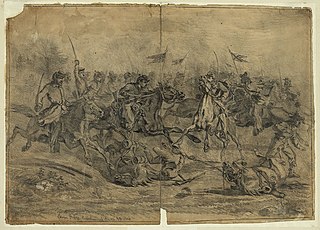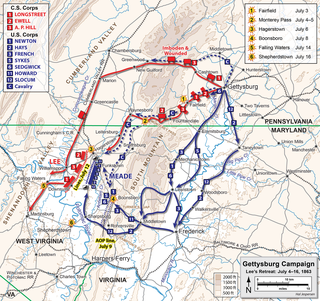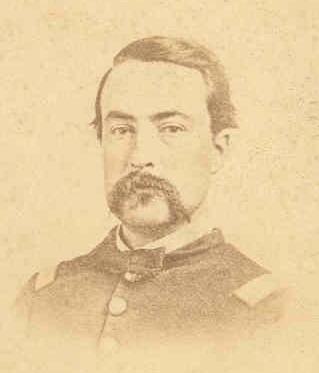Related Research Articles

The Battle of Gettysburg was a three-day battle in the American Civil War fought between Union and Confederate forces between July 1 and July 3, 1863, in and around Gettysburg, Pennsylvania. The battle, which was won by the Union, is widely considered the Civil War's turning point, ending the Confederacy's aspirations to establish an independent nation. It was the Civil War's bloodiest battle, claiming over 50,000 combined casualties over three days. Union Major General George Meade's Army of the Potomac defeated attacks by Confederate General Robert E. Lee's Army of Northern Virginia, halting Lee's invasion of the North and forcing his retreat.

James Ewell Brown "Jeb" Stuart was a Confederate army general and cavalry officer during the American Civil War. He was known to his friends as "Jeb,” from the initials of his given names. Stuart was a cavalry commander known for his mastery of reconnaissance and the use of cavalry in support of offensive operations. While he cultivated a cavalier image, his serious work made him the trusted eyes and ears of Robert E. Lee's army and inspired Southern morale.

The Michigan Brigade, sometimes called the Wolverines, the Michigan Cavalry Brigade or Custer's Brigade, was a brigade of cavalry in the volunteer Union Army during the later half of the American Civil War. Composed primarily of the 1st Michigan Cavalry, 5th Michigan Cavalry, 6th Michigan Cavalry and 7th Michigan Cavalry, the Michigan Brigade fought in every major campaign of the Army of the Potomac from the Battle of Gettysburg in July 1863 to the Confederate surrender at Appomattox Court House in April 1865.

The Battle of Brandy Station, also called the Battle of Fleetwood Hill, was the largest predominantly cavalry engagement of the American Civil War, as well as the largest ever to take place on American soil. It was fought on June 9, 1863, around Brandy Station, Virginia, at the beginning of the Gettysburg Campaign by the Union cavalry under Maj. Gen. Alfred Pleasonton against Maj. Gen. J. E. B. Stuart's Confederate cavalry.

The Battle of Kelly's Ford, also known as the Battle of Kellysville or Kelleysville, took place on March 17, 1863, in Culpeper County, Virginia, as part of the cavalry operations along the Rappahannock River during the American Civil War. It set the stage for Brandy Station and other cavalry actions of the Gettysburg Campaign that summer. Twenty-one hundred troopers of Brig. Gen. William W. Averell's Union cavalry division crossed the Rappahannock to attack the Confederate cavalry that had been harassing them that winter. Brig. Gen. Fitzhugh Lee counterattacked with a brigade of about 800 men. After achieving a localized success, Union forces withdrew under pressure in late afternoon, without destroying Lee's cavalry.

The Battle of Hanover took place on June 30, 1863, in Hanover in southwestern York County, Pennsylvania, as part of the Gettysburg Campaign of the American Civil War.

The Gettysburg campaign was a military invasion of Pennsylvania by the main Confederate army under General Robert E. Lee in summer 1863. It was the first time during the war the Confederate Army attempted a full-scale invasion of a free state. The Union won a decisive victory at Gettysburg, July 1–3, with heavy casualties on both sides. Lee managed to escape back to Virginia with most of his army. It was a turning point in the American Civil War, with Lee increasingly pushed back toward Richmond until his surrender in April 1865. The Union Army of the Potomac was commanded by Maj. Gen. Joseph Hooker and then by Maj. Gen. George G. Meade.

David McMurtrie Gregg was an American farmer, diplomat, and a Union cavalry general in the American Civil War.

William Edmondson "Grumble" Jones was a Confederate cavalry general with a reputation for being a martinet to his troopers and fractious toward superiors, but acknowledged to be a good commander. After disagreements of a personal nature with J.E.B. Stuart, Jones's brigade was set to guarding supply lines and unavailable during a crucial juncture of the Gettysburg Campaign when Lee suffered from a lack of capable reconnaissance cavalry. As the personality clash between Jones and Stuart escalated, Jones faced charges for impertinence, and was transferred to separate him from Stuart. Jones was killed leading a counter-attack in the 1864 Battle of Piedmont.

Two corps of the Union Army were called Cavalry Corps during the American Civil War. One served with the Army of the Potomac; the other served in the various armies of the western theater of the war.

Hugh Judson Kilpatrick was an officer in the Union Army during the American Civil War, achieving the rank of brevet major general. He was later the United States Minister to Chile and an unsuccessful candidate for the U.S. House of Representatives.

On the third day of the Battle of Gettysburg during the disastrous infantry assault nicknamed Pickett's Charge, there were two cavalry battles: one approximately three miles (5 km) to the east, in the area known today as East Cavalry Field, the other southwest of the [Big] Round Top mountain.
The Battle of Carlisle was an American Civil War skirmish fought in Pennsylvania on the same day as the Battle of Gettysburg, First Day. Stuart's Confederate cavalry briefly engaged Union militia under Maj. Gen. William F. "Baldy" Smith at Carlisle and set fire to the Carlisle Barracks. Stuart's cavalry withdrew and arrived at the Battle of Gettysburg, Second Day, to the annoyance and concern of Gen. Robert E. Lee.

Thomas Casimer Devin was a United States Army officer and general. He commanded Union cavalry during the American Civil War and during the Indian Wars.
The Affair at Glenmore Farm was a small cavalry skirmish that took place October 16, 1862 in Loudoun County, Virginia between Confederate forces under First Lieutenant Frank Myers and Union forces under General John Geary during the American Civil War. The skirmish resulted in a Union victory.

The Fight at Monterey Pass (or Gap) was an American Civil War military engagement beginning the evening of July 4, 1863, during the Retreat from Gettysburg. A Confederate wagon train of Lt. Gen. Richard S. Ewell's Second Corps, Army of Northern Virginia, withdrew after the Battle of Gettysburg, and Union cavalry under Brig. Gen. H. Judson Kilpatrick attacked the retreating Confederate column. After a lengthy delay in which a small detachment of Maryland cavalrymen delayed Kilpatrick's division, the Union cavalrymen captured numerous Confederate prisoners and destroyed hundreds of wagons.

The Confederate Army of Northern Virginia began its Retreat from Gettysburg on July 4, 1863. Following General Robert E. Lee's failure to defeat the Union Army at the Battle of Gettysburg, he ordered a retreat through Maryland and over the Potomac River to relative safety in Virginia.

Ira Wallace Claflin was a United States Army West Point regular officer who took command of the 6th US Cavalry during the critical days of July 1863 during the Gettysburg Campaign. He was an instructor of Union cavalry tactics for West Virginia and later taught at West Point.

The Battle of Fairfax Court House was fought during the Gettysburg Campaign of the American Civil War between two cavalry detachments from the Union Army of the Potomac, commanded by General Joseph Hooker, and the Confederate Army of Northern Virginia, commanded by General Robert E. Lee.
The 1st Delaware Cavalry Battalion was a cavalry regiment of the Union Army in the American Civil War. Raised in late 1862, the 1st Delaware Cavalry Battalion was initially to be raised as the 1st Delaware Cavalry Regiment, but was reduced to a battalion due to the inability of the state to fill a cavalry regiment to full strength. It served on provost duty in Maryland and Delaware from 1863 to early 1864, and fought in the action at Westminster known as Corbit's Charge during the Gettysburg Campaign. It participated in the Overland Campaign in June 1864, then returned to Maryland after the Confederate cavalry raid of Jubal Early. It remained there for the remainder of the war, and was mustered out after its end.
References
- ↑ "Corbit's Charge". Archived from the original on 21 June 2013. Retrieved 3 July 2013.
- ↑ Roldan, Rodney. "Civil War Documentary – Corbit's Charge". YouTube. Retrieved 3 July 2013.